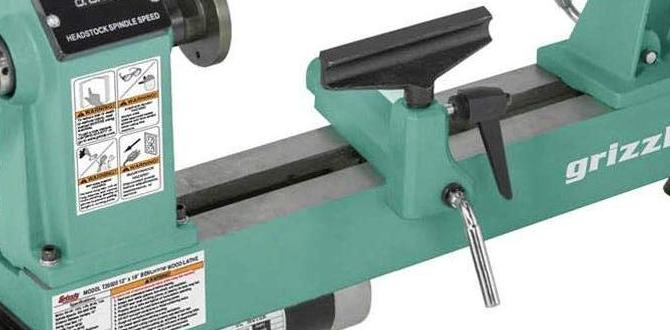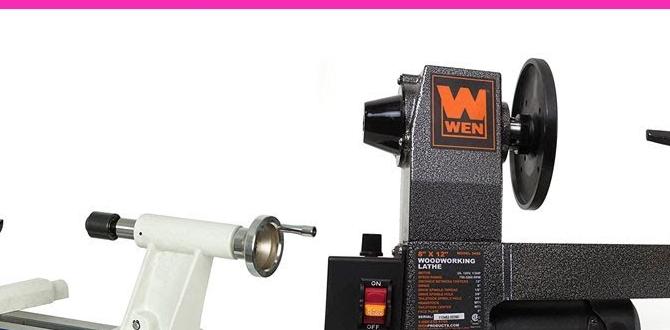In the realm of woodworking, the selection of the best wood lathes plays a pivotal role in achieving precision and artistry. These machines, characterized by their rotational capability and versatility, are essential for shaping a multitude of wood types. By integrating advanced features such as variable speed control, digital displays, and robust construction, the best wood lathes offer woodworkers enhanced performance and reliability. With a plethora of options available on the market, understanding key specifications like swing diameter and spindle speed becomes crucial.
Dive into this exploration of the best wood lathes to discover how they can elevate your craftsmanship to new heights.
Discover The Best Wood Lathes For Every Skill Level

Understanding Wood Lathes
Definition and function of wood lathes. History and evolution of wood lathe technology. Different types of wood lathes (benchtop, midi, fullsize).
Wood lathes are tools that shape wood into various forms by spinning it. They have a rich history, evolving from manual designs to advanced machines used today. Early lathes relied on foot pedals for rotation, while modern ones use electric motors. There are three main types of wood lathes:
- Benchtop: Compact and ideal for small projects.
- Midi: Versatile for both small and medium items.
- Full-size: Best for larger pieces and professional use.
This variety allows woodworkers to choose a lathe that suits their needs and skill level.
Key Features to Consider When Buying a Wood Lathe
Motor power and speed variability. Swing capacity and bed length. Material and build quality. Tool rest and tailstock features.
Choosing the right wood lathe involves considering several important features. Start with motor power; a stronger motor can handle tougher materials and offers varied speed options. Next, check the swing capacity and bed length to ensure it matches your project sizes. Quality materials contribute to the lathe’s durability.
Also, look for useful tool rest and tailstock features for ease and precision in your work.
- Motor Power: Stronger motors allow for better performance.
- Speed Variability: More options give you control over your projects.
- Swing Capacity: Determines the size of items you can work on.
- Bed Length: Affects the overall size and stability.
- Material Quality: Durable construction ensures long-term use.
- Tool Rest Features: Provides stability while working.
- Tailstock Features: Allows for precise setups.
Setting Up Your Wood Lathe
Necessary tools and equipment for setup. Stepbystep installation guide. Safety precautions to take when setting up.
First, gather your best friends: tools! You’ll need a wrench, screwdrivers, and a level. These tools are like the cheerleaders of your setup team.
Step 1: Place the lathe on a sturdy surface. Step 2: Use the level to make sure everything is straight, or it will be like a roller coaster ride! Step 3: Secure it in place, like a cat sitting on a warm laptop. Now, for safety, always unplug the lathe while working on it, and wear safety goggles.
You don’t want sawdust in your eyes!
| Tool | Purpose |
|---|---|
| Wrench | To tighten bolts |
| Screwdrivers | For assembling parts |
| Level | To ensure it’s straight |
Techniques and Tips for Using a Wood Lathe
Basic turning techniques for beginners. Advanced techniques for experienced woodworkers. Common mistakes to avoid while using a lathe.
Starting with a wood lathe? Master the basics first! Hold your tools steady and let the lathe do the spinning work. Remember, smooth motion is key.
For advanced users, try your hand at *fine detailing* and unique shapes. It’s like carving a mini masterpiece! But watch out—common mistakes include cutting too fast or forcing your tool.
These can lead to wobbly results or worse, an unexpected flying piece! Keep your eye on the wood, and it’ll love you back!
| Common Mistakes | Tips to Avoid Them |
|---|---|
| Cutting too fast | Slow down and let the tool do the work |
| Forcing the tool | Use a light touch and let it glide |
| Uneven pressure | Keep a steady hand for smooth shapes |
Maintenance and Care for Longevity
Routine maintenance tips. Cleaning and lubrication procedures. Troubleshooting common issues.
To keep your lathe running smoothly, follow these tips for routine maintenance:
- Check and tighten all bolts regularly.
- Clean dust and debris after each use.
- Lubricate moving parts to prevent wear.
If you notice any issues, troubleshoot them quickly. Common problems include:
- Unusual noises: Check for loose parts.
- Vibration: Balance your workpieces properly.
- Power loss: Inspect electrical connections.
By maintaining your lathe, you ensure its longevity and improve your woodworking experience.
Conclusion
In conclusion, selecting the best wood lathe hinges on your specific needs, whether you’re a beginner or a seasoned professional. With various options available, focusing on quality, features, and user reviews will ensure you make a well-informed decision. Investing in the right lathe can significantly enhance your woodworking projects and elevate your craftsmanship to new heights. Happy turning!
FAQs
What Are The Key Features To Look For When Selecting The Best Wood Lathe For Beginners?When selecting the best wood lathe for beginners, key features to consider include the lathe’s size and weight, as they impact stability and ease of use. A variable speed control is essential for different turning tasks, allowing for greater versatility. Additionally, look for a lathe with a solid construction and good safety features, such as a reliable on/off switch. Finally, ensure it has a user-friendly setup and ample support for accessories and tools to aid learning.
How Does The Size And Power Of A Wood Lathe Affect Its Performance And Versatility?The size and power of a wood lathe significantly influence its performance and versatility by determining the types and sizes of projects it can handle. A larger, more powerful lathe can accommodate bigger workpieces and sustain higher cutting speeds, leading to smoother finishes and more efficient material removal. Conversely, smaller lathes are typically limited to lighter and smaller projects, which may restrict the variety of work a woodworker can undertake. Ultimately, choosing the right size and power depends on the intended applications and the skill level of the user.
What Are The Differences Between Benchtop And Floor-Standing Wood Lathes, And Which Is Better For Home Workshops?Benchtop wood lathes are compact, portable, and designed for smaller projects, making them ideal for limited workspace, while floor-standing lathes are larger, more powerful, and capable of handling bigger pieces of wood for more extensive projects. Benchtop models typically have lower horsepower and fewer features, whereas floor-standing lathes offer greater stability and versatility. For home workshops with limited space or for beginners, a benchtop lathe may be the better choice, whereas experienced woodworkers or those with ample space may prefer a floor-standing lathe for its enhanced capabilities. Ultimately, the best option depends on the user’s projects, available space, and skill level.
Can You Recommend Some Of The Top Brands Known For Producing High-Quality Wood Lathes?Certainly! Some of the top brands known for producing high-quality wood lathes include Jet, Grizzly, Powermatic, and Rikon. These brands are renowned for their durability, precision, and a range of features suitable for both beginners and experienced woodworkers. Additionally, Laguna Tools is also gaining popularity for its innovative designs and performance. When choosing a wood lathe, consider your specific needs and preferences to find the best fit.
What Safety Precautions Should Woodturners Take When Using A Wood Lathe?Woodturners should always wear appropriate personal protective equipment, including safety goggles and a dust mask, to protect against flying debris and inhalation of harmful particles. It’s crucial to secure loose clothing and long hair to prevent getting caught in the lathe. Regularly inspect tools and equipment for damage and ensure that the workpiece is properly secured before starting the lathe. Lastly, maintain a clean work area to minimize trip hazards and ensure safe access to the lathe.
